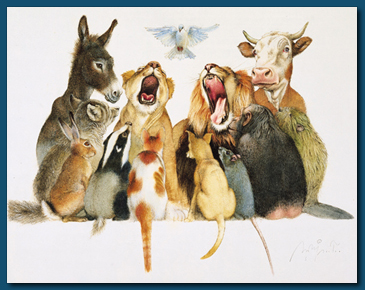

|
 Pfingsten, das liebliche Fest, war gekommen |
The
story was originally a parody of courtly society, and a satirical mirror
held up to the prince. Goethe turned it into a "mirror of the court
and the regent", revealing human weaknesses and vices. Reineke
is transformed from the evil villain to the mischievous buffoon. |
||
|
Again
Prechtl does not illustrate the picture in the strict sense of the word.
His twenty watercolours and pen-and-ink drawings of animals become an
independent work. They do refer to the story, but often go far beyond
it. Sometimes clear historical references are made (Ein Laich, ein
Teich, ein Führer), and sometimes there are ambivalent references
to contemporary politics (Katerfrühstück).
|
|||